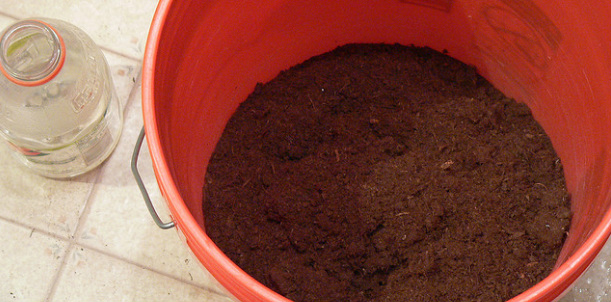How to Make Soil Mix for Container Gardens
One of the most common mistakes new gardeners make when creating container gardens is using the wrong type of soil. They assume that potting soil sold in hardware and home supply stores contains everything they need and simply purchase bags of soil and fill the containers
.All-purpose Potting Soil is Too Heavy
All-purpose potting soil is typically heavy and compacts easily when watered. Not only does it tend to become soggy and choke out oxygen to young roots, it makes it difficult to move planters once they are filled.
Peat Moss is too Acidic
Some make the mistake of using peat moss in place of soil because it is lightweight, but this poses the risk of acidic soil that may injure plants or inhibit healthy growth. The best solution is to mix your own potting soil with a combination of materials.
Components of Good Potting Soil
Recipes for potting mixtures vary by ingredients, but nearly all recipes contain peat moss, soil or compost, and vermiculite or perlite. Adding lime offsets the acidic properties of peat moss.
Recipe for All-Purpose Potting Soil
For a basic all-purpose recipe for potting soil, combine one bushel each of all-purpose potting soil or compost, peat moss, and perlite in a large bin or container. Add 10 to 15 tablespoons of lime, 7 tablespoons of super phosphate or bone meal, and 1 cup of 5-10-10 fertilizer. Mix well to evenly distribute all ingredients. This creates a lightweight potting mixture with all the nutrients you plants need to thrive.
Storing Potting Soil Mix
Many gardeners prefer to keep a supply of premade soil in a large bin for use throughout the gardening season. Unless your bin of soil is housed inside a planting shed or greenhouse, make sure it has an airtight seal to prevent rainwater from entering-unless of course, you prefer soupy soil.
Filling Containers with Potting Soil Mix
Fill containers 3/4 full with potting soil mixture and water thoroughly until water runs freely through the bottom of the container. The soil will settle allowing room for planting and the addition of new soil.
Planting Seedlings in Potting Soil Mix
Position seedlings to their original planting depth and fill in around the roots with soil. Adjust the amount of soil as necessary. Firm the soil down around the roots and against the stem to secure the plants and remove air pockets. Air pockets prevent roots from contacting the soil and pose the risk of injury. For healthy growth, young roots must have access to both water and nutrients. Allow approximately two inches between the top of the soil and the rim of the container for watering.
Don't rely on potting soil or peat moss alone. Take the time to mix your own potting soil mix for container gardens to promote healthy growth and provide young roots with the texture and nutrients they need to support thriving plant growth.
.All-purpose Potting Soil is Too Heavy
All-purpose potting soil is typically heavy and compacts easily when watered. Not only does it tend to become soggy and choke out oxygen to young roots, it makes it difficult to move planters once they are filled.
Peat Moss is too Acidic
Some make the mistake of using peat moss in place of soil because it is lightweight, but this poses the risk of acidic soil that may injure plants or inhibit healthy growth. The best solution is to mix your own potting soil with a combination of materials.
Components of Good Potting Soil
Recipes for potting mixtures vary by ingredients, but nearly all recipes contain peat moss, soil or compost, and vermiculite or perlite. Adding lime offsets the acidic properties of peat moss.
Recipe for All-Purpose Potting Soil
For a basic all-purpose recipe for potting soil, combine one bushel each of all-purpose potting soil or compost, peat moss, and perlite in a large bin or container. Add 10 to 15 tablespoons of lime, 7 tablespoons of super phosphate or bone meal, and 1 cup of 5-10-10 fertilizer. Mix well to evenly distribute all ingredients. This creates a lightweight potting mixture with all the nutrients you plants need to thrive.
Storing Potting Soil Mix
Many gardeners prefer to keep a supply of premade soil in a large bin for use throughout the gardening season. Unless your bin of soil is housed inside a planting shed or greenhouse, make sure it has an airtight seal to prevent rainwater from entering-unless of course, you prefer soupy soil.
Filling Containers with Potting Soil Mix
Fill containers 3/4 full with potting soil mixture and water thoroughly until water runs freely through the bottom of the container. The soil will settle allowing room for planting and the addition of new soil.
Planting Seedlings in Potting Soil Mix
Position seedlings to their original planting depth and fill in around the roots with soil. Adjust the amount of soil as necessary. Firm the soil down around the roots and against the stem to secure the plants and remove air pockets. Air pockets prevent roots from contacting the soil and pose the risk of injury. For healthy growth, young roots must have access to both water and nutrients. Allow approximately two inches between the top of the soil and the rim of the container for watering.
Don't rely on potting soil or peat moss alone. Take the time to mix your own potting soil mix for container gardens to promote healthy growth and provide young roots with the texture and nutrients they need to support thriving plant growth.
